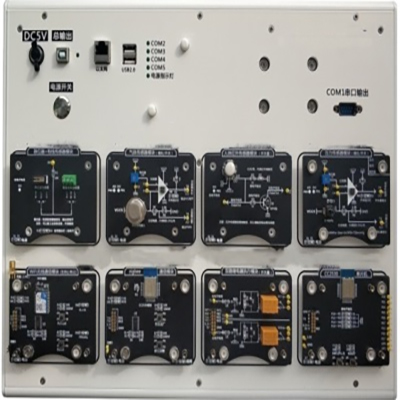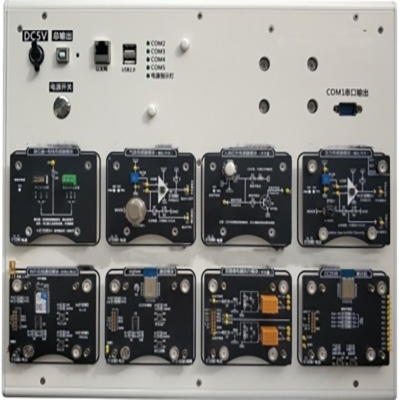GLW-2A Internet of Things Experiment Box is a teaching and training equipment for electronic information, computer and Internet of Things majors. It is mainly composed of a mainboard, sensor kit, single-chip kit, actuator kit, automatic identification kit, computer, operating table, sensor network application development training kit cable package, switch, router, cloud platform, development tools and training guide.
GLW-2A Internet of Things Experiment Box
Ⅰ、Equipment Introduction
GLW-2A Internet of Things Experiment Box is a teaching and training equipment for electronic information, computer and Internet of Things majors. It is mainly composed of a motherboard, sensor kit, single-chip kit, actuator kit, automatic identification kit, computer, operation table, sensor network application development training kit cable package, switch, router, cloud platform, development tools and training guide.
The experimental box is equipped with a high-performance motherboard and expansion interface, and there are a variety of Internet of Things modules and sensor modules to choose from. The motherboard and the module are designed with a non-fixed magnetic suction connection method. They can be directly adsorbed into the corresponding slot of the experimental platform for use without additional wiring. The motherboard slot and the teaching module use elastic probe contacts to provide power supply and signal transmission. Students can arbitrarily connect modules for experiments, complete the basic knowledge of the Internet of Things and complex multi-module networking experiments, and have strong expansibility.
This experimental box is rich in resources and provides dozens of course experiments. It can complete the experimental training of many courses such as single-chip microcomputer technology, embedded systems, RFID technology, ZigBee technology, radio frequency identification technology, wireless communication technology, Internet technology, sensor technology, data acquisition, wireless sensor network, Internet of Things application development, intelligent terminal development, circuit design, integrated circuit technology, and electronic application technology. The course experiment provides open software and hardware resources, focusing on cultivating students' practical hands-on ability, and can realize teaching, scientific research, student graduation design and other related Internet of Things topics.
Ⅱ、Features of the experimental box
GLW-2A Internet of Things experimental box provides common power supplies such as 3.3V, 5V, and 12V, with a maximum current of 10A, which can meet all power supply needs; it provides common interfaces such as serial port, USB port, and Ethernet. The experimental box has compatibility and expandability, which is convenient for secondary upgrades. You can upgrade by purchasing accessories, which can effectively save costs.
1. With integrated power supply, the experimental box only needs to connect a power cord, which is easy to operate;
2. Provide USB interface, J-link download interface, CC-debug download interface, and serial port interface for easy expansion;
3. Built-in USB HUB, through 1 USB HUB, expand 8 USB interfaces, when data is transmitted, the Internet of Things module does not need to connect a separate data cable;
4. It has 8 universal experimental module slots, integrated short-circuit protection design, and supports 8 module linkage experiments. It can carry out multi-module comprehensive application on the basis of learning a single knowledge point, and can complete various complex networking experiments such as wireless sensor network experiments;
5. Provide motherboard reset button and ZigBee simulator reset button. When communication and simulation debugging are confused, just press the reset button to restore the initial state;
6. Integrated virtual instrument acquisition interface (virtual instrument acquisition instrument optional) to facilitate data analysis in Internet of Things experiments;
7. Each COM terminal corresponds to an indicator light (yellow ), when the COM1-COM4 modules are working normally, the indicator light is always on, and there is also a mainboard operation indicator light (blue). When the experimental platform is operating normally, the indicator light is always on;
8. Because it uses a magnetically detachable module, it is easy to upgrade, and once a new module is available, it can be seamlessly connected;
9. The experimental box is divided into two layers. The top layer is the main bottom plate, which adopts an embedded structure and can be combined with modules at will; the bottom layer adopts a partition structure, which can be used to store modules and experimental tools;
10. Covering a wide range of subjects
The experimental box covers experimental training in many disciplines such as sensor technology, embedded technology, Internet of Things engineering, automatic identification, electronic communication engineering, and automation.
Ⅲ、Experimental box configuration:
1. Sensors: can provide light, smoke, gas, atmospheric pressure, pm2.5, ultrasonic, temperature and humidity, soil temperature and humidity, infrared fence, door magnet, human infrared, relay, infrared temperature measurement, DC motor driver, stepper motor actuator, three-axis acceleration sensor and other sensors;
2. Magnetic detachable modules: can provide 51 single-chip microcomputer module, LoRa module, STM32 module, RFID module, LED execution module, ZigBee module, Arduino UNO module, 4G module, NB-IOT module, WiFi module, infrared remote control module, narrowband communication module, IPV6 edge routing communication module and other IoT experimental modules;
3. Smart gateway: This gateway is a self-developed product with a 7-inch touch screen, using Linux/Andriod system, and supporting host computer software.

Synchronous PC version:
GLW-2A Internet of Things Experiment Box https://www.biisun.com/home/category/detail/id/170.html


 Italian
Italian German
German Russian
Russian Turkish
Turkish Portuguese
Portuguese Spanish
Spanish French
French



